| 890 Naval Air Squadron | |
|---|---|
| Active | 1942-1944 1952 1954-56 1960-66 1967 [1] |
| Country | |
| Branch | |
| Part of | Fleet Air Arm |
890 Naval Air Squadron (890 NAS) was a Naval Air Squadron of the Royal Navy's Fleet Air Arm. [2]
| 890 Naval Air Squadron | |
|---|---|
| Active | 1942-1944 1952 1954-56 1960-66 1967 [1] |
| Country | |
| Branch | |
| Part of | Fleet Air Arm |
890 Naval Air Squadron (890 NAS) was a Naval Air Squadron of the Royal Navy's Fleet Air Arm. [2]
Various types of aircraft have been flown by 890 Naval Air Squadron these include:
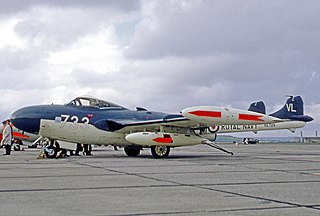
The de Havilland DH.112 Sea Venom is a British postwar carrier-capable jet aircraft developed from the de Havilland Venom. It served with the Royal Navy Fleet Air Arm and with the Royal Australian Navy. The French Navy operated the Aquilon, developed from the Sea Venom FAW.20, built under licence by SNCASE (Sud-Est).
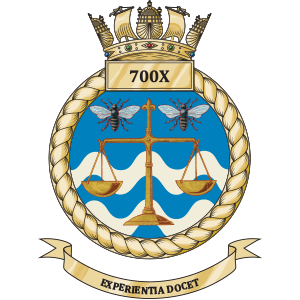
700 Naval Air Squadron is an experimental test squadron in the Royal Navy’s Fleet Air Arm.

892 Naval Air Squadron was a carrier-based fighter squadron of the British Royal Navy's Fleet Air Arm. It was formed in 1943, flying Grumman Martlets, and was the only operational Fleet Air Arm squadron to fly the McDonnell Douglas Phantom FG.1.

792 Naval Air Squadron was a Naval Air Squadron of the Royal Navy's Fleet Air Arm and was originally formed at RNAS St Merryn in August 1940 as an Air Target Unit, equipped with six Blackburn Skuas. The squadron disbanded in 1945 and merged with 794 Naval Air Squadron. 792 Squadron reformed at RNAS Culdrose in 1948 as a Night Fighter Training Unit. It was initially equipped with Fairey Firefly NF.1s and Avro Ansons. They were later replaced with Sea Hornets shortly before the squadron disbanded again in August 1950.
899 Naval Air Squadron was a squadron of the Fleet Air Arm of the United Kingdom.
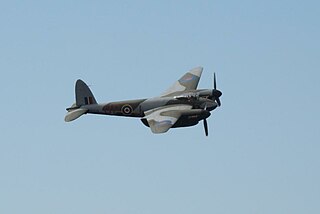
704 Naval Air Squadron was a Naval Air Squadron of the Royal Navy's Fleet Air Arm. It formed as a Operational Training Unit, at RNAS Zeals in Wiltshire, in April 1945, operating with de Havilland Mosquito aircraft. The squadron later moved to RAF Thorney Island in West Sussex, in the September, and continued with de Havilland Mosquito conversion courses, however the squadron disbanded in December 1945.
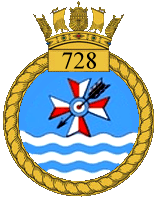
728 Naval Air Squadron was a Naval Air Squadron of the Royal Navy's Fleet Air Arm (FAA). It was formed at the beginning of May in 1943, as a Fleet Requirements Unit, at RN Air Section Gibraltar. It provided detachments at RN Air Section Tafaraoui, in Algeria and later at RAF Oujda in Morocco. Moving to HMS Grebe, RNAS Dekheila, in Egypt, during June, it then merged into 775 Naval Air Squadron during July. It reformed in August, again as a Fleet Requirements Unit, at HMS Grebe, moving immediately to RN Air Section Takali, Malta. It provided target towing both for the Royal Navy's Mediterranean Fleet and the British Army, before later providing a detachment to tow targets for the United States Navy at Naples, Italy. The squadron remained on Malta, alternating between the airbases at Ta Kali, Luqa and Hal Far, until disbanding at the latter, in May 1967.

733 Naval Air Squadron was a Naval Air Squadron of the Royal Navy's Fleet Air Arm. It was active between January 1944 and December 1947, entirely in Ceylon, as a Fleet Requirements Unit, based mainly at R.N. Air Section China Bay, which became HMS Bambara, RNAS Trincomalee, China Bay, Ceylon. The squadron initially formed at R.N. Air Section Minneriya, at RAF Minnerya, Ceylon, two weeks after an advance party arrived there, remaining for three months after formation before relocating.

738 Naval Air Squadron was a Naval Air Squadron of the Royal Navy's Fleet Air Arm (FAA), which last disbanded during May 1970 at HMS Goldcrest, RNAS Brawdy. It initially formed as a Pilot Training Squadron formed at HMS Asbury, RNAS Quonset Point, Rhode Island, in February 1943. The squadron moved to RNAS Lewiston, Maine, United States, at the end of July 1943 and also providing advanced carrier training to American-trained Royal Naval Volunteer Reserve (RNVR) pilots and it later provided complete Torpedo Bomber Reconnaissance (TBR) aircrew for Grumman Avenger FAA squadrons. The squadron moved to RNAS Brunswick, Maine, in February 1945 and disbanded there in July 1945. 738 Naval Air Squadron was next active as part of the Naval Air Fighter School, between May 1950 and March 1954, providing newly qualified FAA pilots the operational techniques of air-to-air and air-to-ground firing. It had formed at HMS Seahawk, RNAS Culdrose, Cornwall, England, moving to HMS Fulmar, RNAS Lossiemouth in 1953. It reformed in April 1954 at HMS Fulmar and now the squadron’s role was to instruct United States trained pilots on the British method and was also responsible for converting the FAA piston-engined pilots onto jet aircraft. It became an Advanced Flying Training Squadron in June 1962 providing training for low-level navigation, ground attack and air-to-air weapons training.
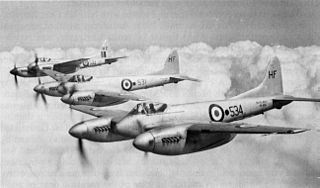
739 Naval Air Squadron was a Naval Air Squadron of the Royal Navy's Fleet Air Arm, which disbanded during 1950. It was formed as the Blind Approach Development Unit for the Fleet Air Arm, operating with Fairey Fulmar and Fairey Swordfish aircraft, at RNAS Lee-on-Solent, in 1942. Just under one year later the squadron moved to RNAS Worthy Down, in late 1943 and continued in the role. Roughly one year later the squadron moved again, relocating to RNAS Donibristle in late 1944, disbanding in 1945. It reformed in 1947 and was based at RNAS Culham, with a new role, as the Fleet Air Arm Photographic Trials and Development Unit.
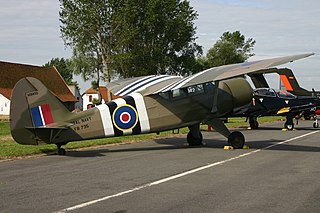
740 Naval Air Squadron was a Naval Air Squadron of the Royal Navy's Fleet Air Arm. It was initially active between May and August in 1943, formed as an Observer Training Squadron at HMS Condor, RNAS Arbroath, Angus, Scotland. From December 1943 to September 1945 it was a Communications Squadron formed at and operated from HMS Landrail, at RNAS Machrihanish, Argyll and Bute, Scotland.

766 Naval Air Squadron was a Naval Air Squadron of the Royal Navy's Fleet Air Arm. It was to have initially formed in 1939 at HMS Daedalus, RNAS Lee-on-Solent, as a Seaplane School, however, it formed at HMS Landrail, RNAS Machrihannish, as a Night ALT Course, in 1942. It moved to HMS Nightjar, RNAS Inskip, in 1943, to become part of No. 1 Naval Operational Training Unit. By 1944, it was operating over 30 Swordfish aircraft, but, during the year, also acquired Firefly aircraft from 1772 NAS, and Sea Hurricane aircraft from 760 NAS. It moved to HMS Merganser, RNAS Rattray, early in 1946, but later that year, moved to HMS Fulmar, RNAS Lossiemouth, where it received Seafire aircraft, along with being Part 1 of the Operational Flying School. By late 1951, Sea Fury trainer aircraft were also added to its varied list of types operated. In 1953, the squadron moved to HMS Seahawk, RNAS Culdrose, where it disbanded in 1954.

769 Naval Air Squadron was a Naval Air Squadron of the Royal Navy's Fleet Air Arm. It last disbanded and merged with 717 Naval Air Squadron after the Second World War. 769 Naval Air Squadron Formed at HMS Merlin, RNAS Donibristle, during May 1939, by renumbering 801 Naval Air Squadron. Its role was a fighter Deck Landing Training Squadron, using HMS Furious for advanced training, before disbanding in the December. It reformed in November 1941, as a unit within the Deck Landing Training School at HMS Condor, RNAS Arbroath, and in November 1943, it moved to HMS Peewit, RNAS East Haven. Its role changed to Torpedo Bomber Reconnaissance Training in 1944, before moving to HMS Merganser, RNAS Rattray, in July 1945.

770 Naval Air Squadron was a Naval Air Squadron of the Royal Navy's Fleet Air Arm. It last disbanded at HMS Nighthawk, RNAS Drem in October 1945. 770 Naval Air Squadron initially formed as a Deck Landing Training Squadron at HMS Daedalus, RNAS Lee-on-Solent, in November 1939. Embarked in HMS Argus, and operated from the aircraft carrier and Hyeres la Palyvestre in the south of France, until it disbanded in May 1940. It reformed at HMS Merlin, RNAS Donibristle, on New Year’s Day 1941, as a Fleet Requirements Unit out of 771 Naval Air Squadron’s 'X' Flight. It moved to HMS Jackdaw, RNAS Crail, in June 1941, then two and half years later it moved to HMS Jackdaw II, RNAS Dunino in January 1944, before finally moving to HMS Nighthawk in July.

775 Naval Air Squadron was a Naval Air Squadron of the Royal Navy's Fleet Air Arm which last disbanded in March 1946. 775 Naval Air Squadron formed at HMS Grebe, RNAS Dekheila, during November 1940, as a Fleet Requirements Unit in support of the Mediterranean Fleet, based at Alexandria, Egypt. Between October 1941 and March 1942 the squadron also included the RN Fighter Flight. It absorbed 728 Naval Air Squadron in July 1943 and moved to R.N.Air Section Gibraltar at the start of February 1944. The squadron returned to HMS Grebe, RNAS Dekheila during August 1945.

780 Naval Air Squadron was a Naval Air Squadron of the Royal Navy's Fleet Air Arm which last disbanded at HMS Seahawk, RNAS Culdrose in November 1949. 780 Naval Air Squadron formed at HMS Raven, RNAS Eastleigh as a Conversion Course Unit, in October 1939, to train experienced civilian pilots in naval flying. It moved to HMS Daedalus, RNAS Lee-on-Solent, in October 1940, and later, its role had changed to converting pilots to Fairey Barracuda aircraft. It spent a year at RNAS Charlton Horethorne, before returning to HMS Daedalus and disbanded, early 1945. In March 1946, the squadron reformed at HMS Godwit, RNAS Hinstock, as the Naval Advanced Flying School, to give flying instructors' courses, and later provided Instrument Flying Training. In December, the squadron moved to HMS Jackdaw, RNAS Crail, then in March 1947 moved to HMS Merlin, RNAS Donibristle, and in May to HMS Seahawk as the first resident unit.

781 Naval Air Squadron was a Naval Air Squadron of the Royal Navy's Fleet Air Arm which disbanded at the end of March 1981. Planned as a Reserve Amphibious Bomber Reconnaissance squadron, it formed as a Communications Unit in March 1940 and operated a large variety of aircraft. It provided a Bristol Beaufighter conversion course which eventually became 798 Naval Air Squadron and also had a ‘B’ Flight at Heathrow and then Heston aerodromes before becoming 701 Naval Air Squadron. After the Allied invasion of Normandy the squadron flew to various Royal Navy units on the continent and established an ‘X’ Flight based in France and then Germany. In July 1945 the squadron disbanded into 782 Naval Air Squadron although the ‘X’ Flight was moved to 799 Naval Air Squadron.

782 Naval Air Squadron was a Naval Air Squadron of the Royal Navy's Fleet Air Arm. It initially formed in October 1939 as an Armament Training Squadron but disbanded in November to provide personnel for 774 Naval Air Squadron. In December 1940 it reformed at HMS Merlin, RNAS Donibristle, as the Northern Communications Squadron, providing links between the Naval Air Stations in Scotland, Northern Ireland, and the Shetland and Orkney islands. It finally disbanded in October 1953.

797 Naval Air Squadron was a Naval Air Squadron of the Royal Navy's Fleet Air Arm which last disbanded in October 1945 in Ceylon. Its role was a Fleet Requirements Unit which formed at HMS Ukussa, Royal Naval Air Station Katukurunda, in Ceylon, in July 1942. The squadron moved to RNAS Colombo Racecourse in October 1943. It had a Communications Flight which became 742 Naval Air Squadron in December 1943 and the following summer it had an ‘X’ Flight deployed for target towing for a couple of gunnery schools in Bombay, India and which eventually moved to 722 Naval Air Squadron.